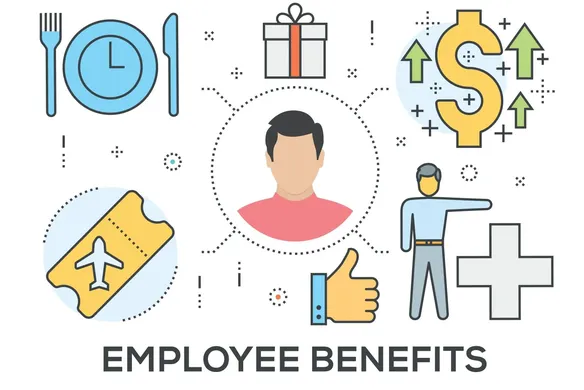Table of contents
It’s a big step and likely feels a little overwhelming — there are a lot of employee benefits that you might provide and you need to familiarize yourself with the options for each one. Not to mention, providing benefits will cost your growing business. But providing benefits that your employees can’t access on their own could open up your business to hire more employees and grow even further.
Remember, when you provide benefits, you’re taking on both a legal and financial responsibility, so make sure you consult with your legal and financial advisors before you make the decision to provide benefits.
Deep Dive
What are employee benefits and why should I provide them?
Employee benefits are the perks employers offer that go beyond traditional compensation, like health insurance, 401(k) plans, and PTO. While benefits do come at a cost to your business, the pros of providing benefits to employees have the potential to outweigh the cons. Here are four reasons that benefits can, well, benefit your business:
- Improved employee recruitment and retention. Benefits are a valuable tool for both attracting and then keeping top talent. Remember, your competitors — whether they be big businesses or small — compete not only for customers but also for employees. Providing benefits puts your compensation packages on par with some of your competitors and may help you surpass others.
- Improved wellness and productivity. Health insurance helps keep employees healthy so they can come to work (and don’t have to take long periods of sick time). Other benefits — like retirement plans — give them peace of mind. All of this means that employees are less distracted and more productive when they are at work.
- Tax advantages. When you start to offer benefits, some tax advantages become available to you. Many businesses are able to deduct plan contributions for health insurance, life insurance, or pension plans. Make sure you speak with your financial or legal advisor about the tax advantages of any plans you decide to provide.
- Positive culture. Harvard Business Review did some research on creating positive workplace cultures and found that two of the major tenets are caring for colleagues as if they were friends and providing support when others are struggling. While you should aim to do that in your personal interactions with your employees, setting up health care and retirement benefits can also send that message
Each of the pros outlined here translates to growth for your business. Being able to recruit top-tier talent means you have the most-skilled people carrying out the day-to-day and big-picture strategies that make your business successful. Making sure talent is happy and healthy means they can focus on executing those strategies. Tax advantages mean you can reduce the amount of money going out, while your employees focus on the amount of money coming in. And a more positive culture leads to a more productive and successful business.
When should I provide benefits?
We understand that offering benefits can seem like a huge task, but there are a few key moments in your business when you know it’s time to offer health care:
As soon as it makes financial sense
We’ve walked you through some of the advantages of providing benefits. So as soon as it is financially viable, you should start investigating how you might provide benefits for your employees. And the right time might be sooner than you think — small businesses can often get discounts if they are bundled with other small businesses through a large carrier.
When you have over 50 employees
When your business reaches 50 employees, the Affordable Care Act mandates that you offer health insurance. There are some large fees associated with not offering health insurance at this point. It’s up to a $2,000 fee per uninsured employee. So if you have 51 employees, it’s a $102,000 fine. That fine alone makes offering health insurance worth it.
If you’re losing talent (or, ideally, before you do)
While 50 employees is the benchmark for being legally required to offer health insurance, if your company reaches a point when you are struggling to retain and attract star employees, it’s time to offer health care. Do your research and see what other companies of similar size in your industry are offering.
What types of health benefits should I provide?
As we touched on earlier, the ACA requires your company to offer affordable health care when your business employs more than 50 people. Even if you don’t have that many employees, though, you might consider providing health benefits.
There are two main categories of insurance you can offer employees:
A defined benefit health plan (also called a group health insurance plan) provides medical care for employees and their dependents either through insurance, reimbursement, or another method. This method offers the same benefits to everyone in the plan. You must be an employee of the company to be part of this group health plan.
A defined contribution health plan gives each employee a fixed dollar amount to spend on health care, rather than providing a defined group plan for all your employees. It’s not a health insurance plan; it’s a program in which employees are responsible for selecting their own individual health insurance plan and making payments for it out of their own finances. They can then use their defined contribution allowance to reimburse themselves.
This can be a more affordable option than an employer-sponsored health insurance plan. Contributions are tax-deductible to the employer and employees receive reimbursements tax-free. Also there are no minimum or maximum contribution amounts, and no minimum participation requirements. But there are a lot of regulations you should be aware of when it comes to this sort of offering, so make sure to consult with your legal and financial advisors.
Whether you provide a group health insurance plan or a defined contribution health plan, there are other health benefits you can provide. Two of them are health savings accounts (HSA) or flexible spending accounts (FSA) for employees:
A health savings account allows your employees to set aside pretax money to pay for qualified medical expenses. HSA funds roll over from year to year, so employees don’t have to worry about spending funds in the same year that they set them aside. But an HSA can be used only if an employee has a high deductible health plan (HDHP) .
There are limits to how much an individual and family can contribute per year. In 2018, individuals can put up to $3,450 pretax dollars into their account, and a family can contribute up to $6,900 per year.
A flexible spending account (FSA) allows employees to contribute pretax earnings into an account that can pay for health care costs like copayments, deductibles, etc. Employers have to sponsor an FSA plan, and eligibility rules are set by the plan. In 2018, employees can contribute up to $2,650 to their health FSAs.
What retirement benefits should I provide?
When you hear people talk about retirement benefits, the term 401(k) probably comes up. A 401(k) plan is a qualified employer-established plan to which employees can make contributions from their salary to save for retirement.
A traditional 401(k) plan allows employees to make pretax contributions, while a Roth 401(k) allows employees to contribute after-tax dollars (and then withdrawals are tax-free).
But 401(k)s aren’t the only type of retirement plan that you can offer your employees. Many small business owners opt to administer SIMPLE IRAs for their employees because they are easy and inexpensive to set up and operate.
In this type of plan, employers are required to either:
- Match their employee’s salary contribution up to three percent of their compensation; or
- Make a nonelective contribution of two percent of their employee’s compensation.
Learn more about 401(k)s, SIMPLE IRAs, and other available retirement benefits in our 401(k) guide for employers.
What other types of employee benefits might I offer my team?
In addition to health care and retirement benefits, there are other benefits that can help you retain and attract the best talent. Paid time off, parental leave, and equity help ensure employees are rested, have high morale, and are invested in your company’s mission.
Paid time off (PTO)
A good paid time off policy can make all the difference when you are recruiting new talent, and it can ensure that your current employees take the necessary time to refresh each year.
Depending on where your business is located, you may be required to provide a certain amount of paid time off.
Once you’ve done your research and figured out if you are required to provide a certain number of days off in your city, county, or state, you can begin to develop a PTO policy. You want to think about the different types of leave you will incorporate into your policy, including sick time, vacation time, personal holidays, national holidays, and bereavement leave, among others. In addition, you want to determine how much leave employees are eligible for, when they earn it, and how they can take leave.
Parental leave
One specific type of paid leave that is often talked about in the news is parental leave. If you have more than 50 employees, the Family and Medical Leave Act requires you to provide at least 12 weeks of unpaid, job-guaranteed leave for childbirth, adoption, and foster care placement for employees who have worked at least 1,250 hours during the preceding year.
(This also applies if an employee has a serious personal medical condition or has to care for a child or spouse with a serious medical condition.)
But many businesses are creating more generous paid parental leave policies to make their businesses more attractive to young talent. You should carefully consider the costs of providing paid parental leave, but also be aware that some cities, counties, and states have their own laws regarding parental leave.
Employee equity
If you’re able to offer it, equity can give employees a sense of excitement and buy-in to help build your company into something big. And if you don’t have enough funding to invest in a benefits package that totally competes with your competitors, equity can even the playing field.
Just remember that offering other people a piece of your business is a big decision that comes with its own considerations. There are a number of ways to structure equity, so you should consult with your legal and financial advisors before making any decisions.
What will employee benefits cost me?
While providing benefits is helpful for your business, it costs money. The exact cost varies based on what benefits you choose to provide and how many people you have opting into the plan.
But administering benefits for your team also takes time (and your time is also worth money). It’s important to properly budget time for this project. Take into account form distribution, plan selection, fielding questions from employees, and complying with all federal laws and mandates like the Affordable Care Act (ACA).
You may find that appointing a person to oversee benefits can help streamline workflow and give employees a point person to whom they can go with questions. But again, there is a cost associated with either hiring a new employee to do this or making it part of a current employee’s duties.
How do I administer employee benefits packages?
Now that you’ve decided the type of benefits you want to offer, you need to administer the benefits. When you administer benefits, you’re responsible for:
- Creating the benefits program
- Enrolling new employees
- Communicating what benefits are available
- Helping employees update benefits selections
- Liaising with providers to ensure your benefits are competitive
- Ensuring benefit providers are paid each month
- Making sure the correct amount is withheld from each employee’s paycheck
There are a few ways to do this: internally, externally, or a combination of the two.
While it may seem less expensive to administer the benefits internally, carefully consider the amount of time and work it takes to manage these. Often, small businesses do not have the capacity (or the expertise) to manage benefit administration.
If you choose to outsource your benefit administration, you’ll be relieved of most of your paperwork and compliance requirements. When evaluating benefit administration providers, consider what services they do or do not offer, the cost structure, and compliance assurance. It’s important to plan ahead for rising premium costs from year to year.
There are also a few online platforms that can help you administer some of the benefits yourself and outsource other parts. This allows you to have some guidance in regards to compliance and still benefit from the lower costs of self-administration.
How do benefits affect my payroll?
Once you’ve decided how to administer your benefits, you also need to determine how to make sure you’re deducting the right amount of money from each employee’s paycheck to pay for those benefits.
Square Payroll supports the processing of retirement plans and other pretax deductions.
Once you create a benefit in Square Payroll and set a deduction percentage or fixed amount to be withheld from your employee’s paycheck, we automatically calculate deductions and contributions when you run payroll.
Then we leave the amounts in your bank account so you can distribute it to the applicable providers. Square Payroll also determines the taxability and reporting requirements for each benefit to make sure your taxes and tax forms are accurate. Learn how to set up benefits in Payroll.
Square Payroll can help you keep track of paid time off and sick leave. You can set up PTO policies for each employee based on hours worked or you can set a fixed amount. Employees can view their PTO balance on their pay stubs. Learn how to set up paid time off in Payroll.
Offering benefits requires a fair amount of time and there are costs associated with them — but the real benefit is in your employees’ satisfaction and wellness.
Ready to offer employee benefits?
Square Payroll partners with leading benefits providers so you and your team can access health insurance, 401(k), and more — all in one place.
If you already use Square Payroll, you can enroll in benefits directly from the Square Payroll dashboard. You can choose the benefits that best suit your needs and budget, and we’ll take care of everything else, from employee enrollment to calculating deductions and contributions for each pay run. Square Payroll also determines the taxability and reporting requirements for each benefit to make sure your taxes and tax forms are accurate.
Create an account with Square Payroll to learn more about signing up for benefits. Or, if you already have benefits that you want to sync with Square Payroll, learn about adding your benefits to Payroll in our Support Center.
![]()















